History
Columbian Exchange Culture
The Columbian Exchange Culture refers to the widespread exchange of plants, animals, foods, human populations, and diseases between the Eastern and Western Hemispheres following Christopher Columbus's voyages to the Americas in the late 15th and early 16th centuries. This cultural exchange had a profound impact on the development of societies and economies on both sides of the Atlantic, shaping the modern world.
Written by Perlego with AI-assistance
Related key terms
6 Key excerpts on "Columbian Exchange Culture"
- eBook - ePub
Atlantic Lives
A Comparative Approach to Early America
- Timothy Shannon(Author)
- 2019(Publication Date)
- Routledge(Publisher)
2 The Columbian ExchangeFigure 2.1 Smallpox among the Nahuatl in Sixteenth-Century Mexico.Of the many diseases transmitted across the Atlantic in the Columbian Exchange, smallpox was the most deadly for Native Americans (see Selection 2). Considered a childhood disease in Europe, in America it led to fatality rates that ranged from 30 to 90 percent of infected populations. This image of Native Americans suffering from smallpox comes from a sixteenth-century Spanish collection about the Aztecs.Source: Florentine Codex, Book XII folio 54. Bernardino de Sahagún, Historia general de las cosas de la Nueva España (1540–1585).Introduction
The passage of human beings between the Old World and the New led to a much wider transfer of plant and animal life commonly known as the Columbian Exchange. Some of this exchange occurred by design, such as when Old World farmers planted American crops in their fields; other times, the exchange was inadvertent, such as when colonists unwittingly introduced new diseases to Native American populations. Whether purposeful or accidental, such exchanges forever altered the nature of plant, animal, and human life on both sides of the Atlantic. Formerly isolated ecosystems became intertwined and transformed in the process. Some species experienced extinction or near extinction, while others flourished in new surroundings unchecked by natural enemies. While scholars have typically studied the human actors involved in this drama, we cannot appreciate the full impact of the Columbian Exchange without considering the other forms of life it affected.The most profound changes wrought by the Columbian Exchange resulted from the transmission of microbes from the Old World to the New. European sailors, explorers, traders, and colonists brought to the Americas a number of diseases to which Native Americans had had no previous exposure, and therefore, no natural immunities. Smallpox, measles, influenza, bubonic plague, and others broke out in “virgin-soil epidemics” among these new host populations. Estimating the impact that these diseases had on Native Americans has become a contentious business among scholars, involving debates over the pre-Columbian population of the Americas and the fatality rates associated with virgin-soil epidemics. On the high end, some scholars estimate that as many as 18 million Indians lived in North America prior to 1492, and that Old World microbes reduced that number by as much as 95 percent. More conservative estimates place the pre-Columbian population of North America at 4–7 million, with a 60–70 percent reduction in that number by 1700. - eBook - ePub
The American Yawp
A Massively Collaborative Open U.S. History Textbook, Vol. 1: To 1877
- Joseph L. Locke, Ben Wright(Authors)
- 2019(Publication Date)
- Stanford University Press(Publisher)
2 Colliding CulturesI. IntroductionTheodor de Bry, Negotiating Peace with the Indians , 1634. Virginia Historical Society.The Columbian Exchange transformed both sides of the Atlantic, but with dramatically disparate outcomes. New diseases wiped out entire civilizations in the Americas, while newly imported nutrient-rich foodstuffs enabled a European population boom. Spain benefited most immediately as the wealth of the Aztec and Incan Empires strengthened the Spanish monarchy. Spain used its new riches to gain an advantage over other European nations, but this advantage was soon contested.Portugal, France, the Netherlands, and England all raced to the New World, eager to match the gains of the Spanish. Native peoples greeted the new visitors with responses ranging from welcoming cooperation to aggressive violence, but the ravages of disease and the possibility of new trading relationships enabled Europeans to create settlements all along the western rim of the Atlantic world. New empires would emerge from these tenuous beginnings, and by the end of the seventeenth century, Spain would lose its privileged position to its rivals. An age of colonization had begun and, with it, a great collision of cultures commenced.II. Spanish AmericaSpain extended its reach in the Americas after reaping the benefits of its colonies in Mexico, the Caribbean, and South America. Expeditions slowly began combing the continent and bringing Europeans into the modern-day United States in the hopes of establishing religious and economic dominance in a new territory.Juan Ponce de León arrived in the area named La Florida in 1513. He found between 150,000 and 300,000 Native Americans. But then two and a half centuries of contact with European and African peoples—whether through war, slave raids, or, most dramatically, foreign disease—decimated Florida’s indigenous population. European explorers, meanwhile, had hoped to find great wealth in Florida, but reality never aligned with their imaginations. - eBook - ePub
Virtual History
How Videogames Portray the Past
- A. Martin Wainwright(Author)
- 2019(Publication Date)
- Routledge(Publisher)
The presence of coffee and sugar in Central America today tells an important story. It’s the story of the “Columbian Exchange,” the transfer of people, commodities, and diseases between the Old and New Worlds, and among regions of both groupings of continents, in the centuries following Columbus’s opening of regular contact between the Americas and Afro-Eurasia. This story is a central focus of modern historical analyses pertaining to European expansion, and European expansion is one of the major themes of Europa Universalis, as well as other grand strategy games that cover the period, including Sid Meier’s Civilization. In fairness to Paradox, the development team includes the Columbian Exchange as an “institution” that modifies productivity in Europe. This institution is supposed to emulate the effect of certain commodities, such as potatoes, in the European diet. However, this level is much more abstract than, for instance, having Europeans find a Central American territory producing chocolate (a New World crop) and turning it over to coffee cultivation. That neither the Europa Universalis nor Civilization series highlight the Columbian Exchange is evidence of at least two potential challenges to portraying the impact of humans on the environment and vice versa. One is the limitations inherent in making commercial videogames simple enough to attract a large market. The other is the extent to which game designers consider environmental aspects of history to be a priority. These challenges are important because human interaction with the physical environment has played an increasingly important role in the work of historians and other scholars dealing with the past. This chapter examines how well videogames deal with environmental issues while explaining how scholars have argued that the environment and human history are interconnected - eBook - ePub
The Caribbean
A History of the Region and Its Peoples
- Stephan Palmié, Francisco A. Scarano, Stephan Palmié, Francisco A. Scarano(Authors)
- 2013(Publication Date)
- University of Chicago Press(Publisher)
Conversely, for Europe the New World meant an increase in wealth and power through the possession of a territory several times larger than itself as a source of raw materials, food, and merchandise for its industries and, moreover, as a place to which excess European population could be sent. On intellectual and spiritual levels, Europe’s mental horizons expanded as a good number of old assumptions about geography, history, theology, nature, and humankind were challenged. For Spain, dominion in America and the invocation of a civilizing mission helped lay the foundations for an era of hegemony that endured until the mid-17th century. This marked the birth of the first great transoceanic empires, whose price was a high level of social conformity and submission to metropolitan authority (Elliot 1970).With the colonization of the New World, the scope of conflicts between European states extended beyond their immediate geographic space. The Caribbean was one of the principal settings for these conflicts through the actions of corsairs, pirates, and buccaneers during the 16th and 17th centuries, contributing to the undermining of Spanish power. In the end, Spain’s weakening opened the door to forcible occupation of several territories in the Lesser and Greater Antilles by the English, French, Dutch, and Danish. From the middle of the 17th century, a new phase of plantation slavery began in these areas, which would be fundamental to the processes of wealth accumulation and to the birth of Europe’s industrial era, which was achieved in exchange for great human and environmental tragedy in the Caribbean islands.Translation by Zachary J. Chase WORKS CITEDCarney, Judith A. 2001. “African Rice in the Columbian Exchange,” The Journal of African History 42, no. 3: 337–96.Cook, Noble David. 2002. “Sickness, Starvation, and Death in Early Hispaniola,” Journal of Interdisciplinary History 32, no. 3 (Winter): 349–86.Crosby, Alfred W. 1977. The Columbian Exchange: Biological and Cultural Consequences of 1492 . Westport, CT: Greenwood Press.. 1986. Ecological Imperialism: The Biological Expansion of Europe, 900–1900 . Cambridge: Cambridge University Press.Denevan, William M. 1992. “The Pristine Myth: The Landscape of the Americas in 1492,” Annals of the Association of American Geographers - eBook - ePub
Cultural Anthropology
Global Forces, Local Lives
- Jack David Eller(Author)
- 2020(Publication Date)
- Routledge(Publisher)
The impact on the local societies too was complex and contradictory: sometimes it appeared to freeze their “traditional” cultures at a particular moment in time, while also altering those traditions or destroying them and generating new ones. Even before modern colonialism, it would be false to insist that indigenous societies were static or totally isolated. However, by the year 1500 we see the seeds of contemporary globalization, in which distant societies would become enmeshed economically, politically, technologically, and “culturally.” Societies were increasingly integrated into national, regional, and ultimately global systems in which the events, decisions, and policies of any one society, state, or region affected other and perhaps all societies. In fact, that wider social context became part of their contemporary culture. It is impossible to understand the modern world apart from colonialism. ETHNOGRAPHIC ARCHIVE – CHAPTER 13 THE ANTHROPOLOGY OF COLONIALISM In 1492, when Christopher Columbus and his expedition made landfall in the “New World,” a world-historical expansion and acceleration of cultural forces was already underway that would come to be known as colonialism. Colonialism, as a practice of occupation and exploitation of foreign territories within the political economy of Europe, and eventually as a global pursuit of empire, was to have unparalleled effects. Yet, founding and controlling colonies was not new at all; colonies are not even unique to humans. The word “colony” (Latin colonia) derives from colonus (farmer), which further derives from colere (to cultivate, also related to the root of our term “culture”). A colony is a segment of a population that moves into and occupies a new territory; as such, there can be not only colonies of humans but of animals, trees, or bacteria - eBook - ePub
Crossing Cultures
Conflict, Migration And Convergence
- Jaynie Anderson(Author)
- 2015(Publication Date)
- Miegunyah Press Digital(Publisher)
naturalia in Rembrandt’s collection, objects sometimes incorporated into his art. In similar fashion, colourful feathers from the Americas emerged from the cultural economy of the Jesuits in colonial Brazil, as examined by Amy Buono, and moved along the European courtly axis, as discussed by Rebecca Parker Brienen. This material transfer illustrates the power and global outreach of both princely rulers and religious missionaries within the new economic system linking Asia and America to Europe. Nicola Courtright reveals how even the literal exchange of princesses across boundaries, in royal marriages—using the symbolism of the body as body politic—embodied treaties and diplomacy for the shared but contested border between France and Spain in the seventeenth century.Finished goods along the trade routes often featured hybrid forms of decorative art-making. Dawn Odell’s study examines the way in which Chinese products and culture combined with Dutch objects in the Dutch colonial capital of Batavia. Julie Hochstrasser considers further the reciprocal influence between Holland and China, particularly with respect to the forms of horizontal spatial composition in maps and travel illustration. At the destination port, Elisabeth de Bièvre has revealed a deeply engrained ‘culture of exchange’ in Europe’s busiest international port, Amsterdam, during its seventeenth-century heyday. In addition to showing how global trade in the entrepot was literally visualised on the new city hall of Amsterdam, she points to surprising connections between trade writ large and unusual biblical and classical subjects within Dutch pictures of the golden age. Her strong grounding of the issue of global outreach from the perspective of the home centre provides a vivid counterpoint to the papers on the Dutch economic and colonial experience from their destinations.Sometimes cultural responses take the form of negative reaction, whether as satire or outright hostility, while ethnographic interest in another culture is shaped by self-interest. Dagmar Eichberger shows how Australians and Europeans constructed the Aboriginal as a primitive other to their civilised modernity, at one with wild animals and nature itself. Cecilia Klein discusses the history of European assessments of the blood rituals of the Aztecs constructed as an antipode to civilisation itself. In contrast, Patricia Simons rescues unfamiliar truths about the Ottoman harem as offering a vestige of classical prestige around Turkish tribadic pleasure rather than serving a colonialist, racialised and erotic fantasy or Orientalising stereotype of Turks as less civilised aliens. These papers remind us of the inevitable historical and ethnographical filters through which we view these past cultures.
Learn about this page
Index pages curate the most relevant extracts from our library of academic textbooks. They’ve been created using an in-house natural language model (NLM), each adding context and meaning to key research topics.





